by Winding Pathways | Dec 15, 2022 | Birds, Garden/Yard, Nature

A chickadee gently cradled in man’s hand.
On an early, warm, bright November day, several Coe and Mt. Mercy University Students with their professors arrived at Winding Pathways to band birds. They stood mesmerized as one cradled a diminutive bird in his hand. This long-distance traveler had met a temporary misfortune.
It was a golden-crowned kinglet, a tiny bird tipping the scales at only .19 ounce. On a recent night, it had winged south from its summer home in the north and decided to rest and feed amid the tall grass and woods at Winding Pathways. Then, it would continue southward. It didn’t know that Dr. Neil Bernstein had other plans.
-
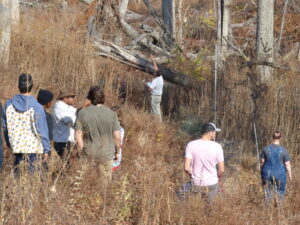
-
Dr. Bernstein sets a mist net by a fallen log.
-
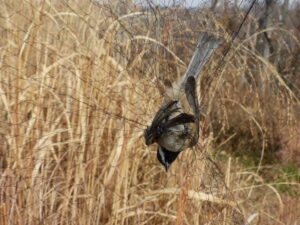
-
trapped chickadee
-
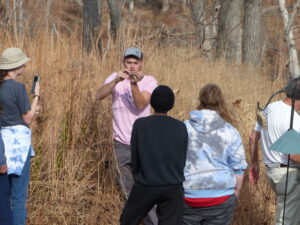
-
Untangling bird
Neil had stretched mist nets an hour earlier. The kinglet, along with chickadees and a Carolina wren didn’t see these fine mesh nets in time. They were caught but uninjured. Neil showed the students how to band birds by gently removing them from the net, weighing each tiny bird, recording data, placing a small lightweight band around its leg, and releasing it. Data are then submitted to help researchers better understand bird migration.
The kinglet and wren waited patiently as students weighed and banded each, but not the chickadees. These bitty, year-round residents have an attitude. They didn’t like being held one bit and pecked at the student’s fingers.
-
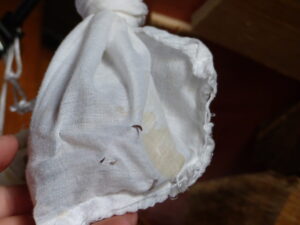
-
A bird’s claws poke through the bag.
-
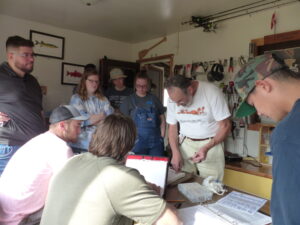
-
Verifying information is important.
-

-
Tiny band ready to attach to a bird
-
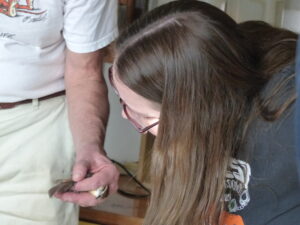
-
Checking feathers
Student Reactions
Students were used to collecting scientific data on different natural topics. They were fascinated by the process of banding birds. “I thought we were going to listen to a bird band!” joked one student. Another envisioned running around chasing birds, concluding that would not work well.
Students commented on how the pecks were sharp but not worrisome. One explained she talked quietly to the chickadee as she carefully held it. Reassuring the bird, she would not hurt it. “I could feel its heart rate slow down,” she commented.
Although chickadees are small, kinglets are even smaller. This kinglet will carry its band as it wings southward but chickadees are homebodies and will wear their bands as they flit around our yard all winter.
Why Band Birds?
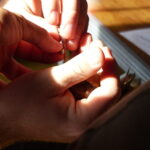
Tiny band with a number.
Banding is a traditional way of learning where birds go, habitat needs, and the impact of climate on both. Perhaps a fellow bander will catch “our” kinglet and inform scientists at the US Geological Survey.
by Winding Pathways | Dec 8, 2022 | Garden/Yard, Mammals, Nature, Travel/Columns
Fair Oaks Farm
A couple of times a year we drive to and from New Jersey to visit relatives. It’s a long thousand-mile slog each way, but we recently discovered an amazing driving break……watching a calf being birthed.
Our fastest route is following Interstate 80, but that involves running a traffic gauntlet in northeast Indiana and paying tolls and boredom along the Ohio and Indiana Turnpikes. On a recent trip, we took a more southern route, mostly following secondary roads to avoid tolls and traffic. Never would we have imagined that, on a driving break, we’d watch a birth!
Cow Adventure
Yup. A birth. We’d been following smallish roads across the Hoosier State and had vaguely heard of Fair Oaks Farm. As our car cleared a rise by an enormous farm field we spotted their colorful water tower and stopped in. It’s really not a farm…but then again it is. Mostly it’s a fascinating living museum of American agriculture, focused on dairy, pork, and crops combined with a hotel, restaurant, and gas station.
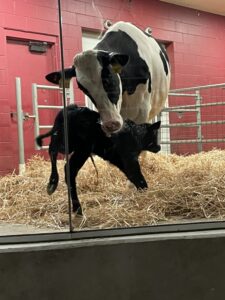
Wobbly legs
After checking in we entered the birthing barn to take in an amazing sight. Two Holstein dairy cows were giving birth, with a human attendant attentively watching to help as needed. As we sat with other families in the darkened seating area, two hooves emerged from each cow. One gave birth quickly. The other struggled until the attending woman helped by gently pulling the calf from her. We, and many others watching, were riveted by the real-time arrival of new living animals. This event brought to mind Marion’s experience growing up on a Maine dairy farm watching a calf being birthed.
From there we enjoyed exhibits telling the story of how crops are grown, dairy cows are cared for, and pork is produced. We walked from building to building enjoying interactive exhibits telling the story of food production. The Farm calls the exhibit areas Crop, Dairy, and Pig Adventures – and they truly are adventurous.
Ninja Warriors in Training
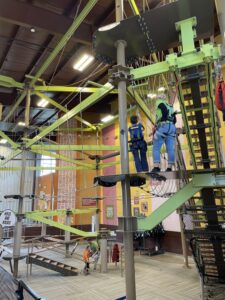
Kids on ropes course
At Pig Adventure we encountered a couple with two small children. “We were on a long drive from Indianapolis to Chicago. The kids were restless in the back seat. So, we stopped. Look at them now,” declared their mom. A young boy and girl were testing their balance on a large complex obstacle course sort of like we see on TV’s American Ninja Warrior. They were harnessed in and guided by employees. Thrills and exercise, yes. Danger, no.
As a seasoned museum professional Rich was impressed at how exhibits were accessible for walking-challenged folks with plenty of places to sit and rest. Yet they gave kids a chance to burn off energy as they moved from exhibit to exhibit. For example, kids could climb small “hills” and slide down the other side to see new displays. One boy operated a hand crank to move large constructed kernels of corn up a vertical elevator to drop into a “silo” and back down for kids to repeat the process. Great learning combined with physical activity. It was, for the family, an educational and exciting way to burn off energy.
Take Time to Experience
We are far from being kids but we gave the crank some turns, also. Then we took a tour break and enjoyed lunch at the site’s eatery, called the Farmhouse Restaurant. As we dined, we watched cheese being made behind a huge glass wall.
We could have boarded a shuttle bus to see actual dairy and pork operations nearby or walk to the orchard and pumpkin patch but time was pressing. We needed to hit the road. So, we will be back.
Visionary Beginnings
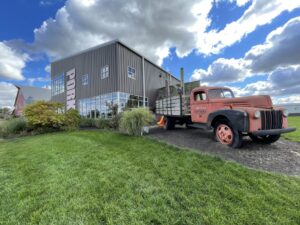
Pig Adventure Starts here!
Fair Oaks Farm was the dream of Mike and Sue McCloskey who began creating it in 1999. It opened a few years later and new exhibits – actually agricultural adventures – are regularly added. Today about 275 staff host thousands of people every year. Jobs for local teens, parents, and grandparents as they warmly welcome visitors.
It’s not all pigs and cows. Many people visit the orchard in the fall to pick apples or the pumpkin patch to stock up on the orange globes for Halloween. Later in the season, there’s ice skating, a forest of lights, and even igloos to enjoy.
The Farm is just off Interstate 94, which links Chicago and Indianapolis. Anyone driving East/West might consider taking smaller roads that parallel Interstate 80 for a less stressful drive that leads past the Farm. For information check out fofarm.com.
by Winding Pathways | Nov 17, 2022 | (Sub)Urban Homesteading, Flowers/Grasses, Garden/Yard, Garden/Yard
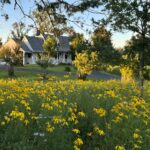
Prairie flowers dance on a knoll.
Motorists passing our yard must think we have a messy yard. Instead of the clipped and sprayed yards of neighbors, ours is a dancing field of tall wildflowers and native grasses. Many consider them “weeds”. Our yard is unconventional, healthy, and beautiful. It attracts desirable wildlife and is dynamic. Visitors, especially children, love walking through six-foot-tall grasses on our labyrinth pathway. To us, pollinators and birds, it’s heaven, not a mess. It is a naturally landscaped yard.
Sugar Grove Farm Paves the Way
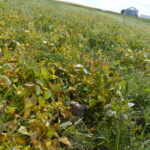
The space between crops is productive in a different way.
Last summer Rich toured Rodale Institute’s plantings at Sugar Grove Farm near Cedar Rapids. Researcher Linda Sturm led him and farmers to plots of vegetables and fields of corn and soybeans before stopping by a long row of what looked like weeds with wildflowers mixed in.
“This is an unproductive area, wasted ground, that could have been planted to corn,” a farmer remarked. Linda countered that it is likely the most productive land on the farm. “It’s the home base for pollinators and birds. They forage in nearby crops to collect nectar and eat insect pests,” she said.
Natural Yards Can Reduce Pests
Same thing at Winding Pathways. Our vegetable garden is amazingly productive despite never using insecticides and only mowing sparingly. Butterflies visit squash, cucumbers, okra and other crops, spreading pollen while wrens constantly forage for insects to feed their hungry young.
A clipped and sprayed lawn is only slightly more attractive to wildlife than pavement. There’s no place for tiny beneficial creatures to live.
-
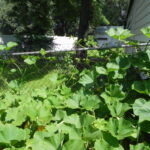
-
Birds and insects forage in the garden.
-
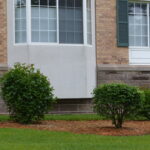
-
This yard offers little to wildlife.
Create Pollinator Patches
Homeowners with small yards can help pollinators and birds by creating islands or strips of welcoming habitat, perhaps in the backyard or along the property line. Linda Strum created habitats within farm fields, and suburban homeowners can enjoy the same benefits. Worry about the neighbor’s reaction? Just create a habitat in the backyard out of sight of passersby.
-

-
Native and cultivated plants brighten a front yard.
-
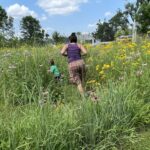
-
Adults and children revel in the natural yard.
-
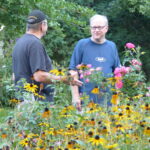
-
Converting a yard to more natural plants brings joy.
Adding birdhouses adds to wildlife fun. We love watching house wrens hunt insects and bring their catch to their babies nestled in a wooden birdhouse dangling down from our porch ceiling.
Given a bit of imagination and fun work even the smallest yard can appear tidy, be aesthetically diverse, and provide homes for butterflies and wondrous spaces for kids and adults.
by Winding Pathways | Oct 20, 2022 | (Sub)Urban Homesteading, Chickens, Garden/Yard
One of our 14 chickens is a true American Ninja Chicken. Most of us know the TV program American Ninja Warriors where athletes navigate extreme obstacles to beat the buzzer. Well, this gal, a California White, is right up there with the most athletic of them all.
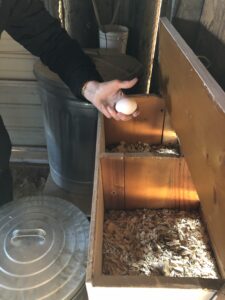
Our American Ninja Warrior Chicken begin to lay eggs at about 20 weeks.
Like most hens, when she reached about 20 weeks old, she laid her first egg in our coop. Then another a couple of days later. Then, none. And, none the next day. That’s unusual. When a hen starts laying, she’ll usually continue.
One evening, Rich counted the hens. There were 13. Hmmmm. Where’s the 14th? Had she met her fate? After recounting three times, checking the run, and scratching his head over this mystery, came a cluck from the attic of the barn. Could she have made the tortuous way up through the rafters into the barn’s attic? Naw. No chicken could do that. Then we remembered that another California White hen had laid eggs in the barn attic. So, Rich got the stepladder and checked anyway.
There she was up in the barn attic above the coop our second American Ninja Chicken proudly looking at her freshly laid egg.
Are Ninja Chickens Dumb Clucks? Not Really
A chicken myth is that they are dumb. Everyone “knows” that. Nope. Not true. To get into the attic our hen had to be both smart and athletic. Brains figured out a pathway through rafters, plywood, spools of wire, and stored items. Athleticism got her there. She negotiated an obstacle course like what we watch on TV’s American Ninja Warrior.
Once she reached the barn attic, she found the darkness and privacy hens appreciate when nesting. Unlike human ninjas,
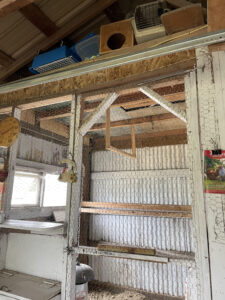
The American Ninja Warrior Chicken wormed her way to the barn attic.
there wasn’t a buzzer to ring when she got up there, but her clucks gave away her presence.
We admire her athleticism and smarts, but laying eggs up there won’t work. We need to easily collect them. So, we spent a morning plugging up any possible route to the attic.
We may have succeeded. Today’s egg was in the coop, but we’re certain she’s trying to figure out how to again reach the attic. She might outwit us.
When do Chickens Start Laying Eggs?
Female baby chicks usually start laying when they are 16 to 24 weeks old. Of the many breeds of chickens those that lay white eggs are relatively small, agile, and intelligent. They can worm their way into inaccessible places and fly like a pheasant. In contrast, most brown egg layers are heavy and cumbersome, and struggle just trying to get airborne.
Our American Ninja hen is a California White, a Leghorn hybrid. She’s small, fast, agile, and determined and lays white eggs – in the attic of the barn.
by Winding Pathways | Sep 22, 2022 | (Sub)Urban Homesteading, Amphibians/Reptiles, Birds, Garden/Yard, Nature
We hadn’t seen either for a while but one September morning there they were. Mr. Toad and Ms. Wren.
Mr. Toad
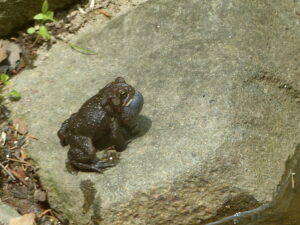
Toads sing loudly day and night.
All summer Mr. Toad contentedly lived beneath a tomato plant snacking on an occasional juicy bug. Ms. Wren meanwhile forayed about the yard snatching bugs and feeding her brood. In September Mr. Toad’s favorite tomato plant died back, probably tired after producing plenty of tasty fruits and no longer able to give Mr. Toad a worthy hiding place. And, after the babies fledged, Ms. Wren worked the prairie grasses and woods.
On that September morning, Rich noticed sweet potato leaves trembling a bit. He brushed aside the foliage and there was Mr. Toad out seeking breakfast.
The fall equinox is almost here. With it comes the short days and cool temperatures that make garden plants shrink. Mr. Toad is cold-blooded. Summer’s moist heat is to his liking, but before the cold comes, he must retire for the winter. So, down he goes, digging into the soil to find a place to snooze through the winter, no doubt dreaming about next summer’s juicy bugs under a new tomato plant.
We bid Mr. Toad adieu for the winter and said, “Thanks for helping with our gardening. See you next spring.”
Ms. Wren
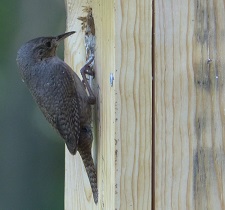
Checking the nest box.
Mr. Toad isn’t our only garden worker. Last winter we set up a wren house and by May Ms. Wren and her partner moved in. The couple raised two broods of ravenous babies in our garden. They enjoy the same fare as Mr. Toad but hunt more in our crop’s leaves instead of under them. The industrious parents spend nearly every daylight hour combing the garden and beyond for insects to feed their chicks.
Our last brood of garden wrens fledged in mid-August but stuck around a while. The family hunts insects in the woods behind the house but by the fall equinox they’ll get the urge to hop on a north wind some night and head south. When we’re shoveling snow, they’ll be snacking on bugs in a warm place.
Parting is Sweet Sorrow When Mr. Toad and Ms. Wren Bid Us Adieu
It’s hard to tell exactly when our wrens leave. Sometimes they linger into October but eventually one of us will say, “I haven’t seen or heard a wren for a while.” Yup, they’ve left for the season. We also bid them adieu and say, “Come back. See you next spring.” We miss Mr. Toad and Ms. Wren for the good work they do and for knowing we provide safe homes for them. We will put up wren boxes come March of next year and search for Mr. Toad sometime when the ground thaws.
About the Equinox
The Fall (autumnal) equinox is on or near September 21st. It’s one of two days when the sun crosses the celestial equator and every place on earth receives approximately 12 hours of daylight and 12 hours of darkness. The other is around March 21, the Vernal equinox. After the fall equinox the dark hours push daylight away until December 21 when days again begin to lengthen in the Northern Hemisphere. Plants and animals are super sensitive to day length and more aware of slight changes than most people.
by Winding Pathways | Sep 15, 2022 | (Sub)Urban Homesteading, Birds, Garden/Yard, Mammals, Nature, Pests
Guest Blog by Jackie Hull,
in the foothills of Virginia
Bears Barely Tolerable Behavior
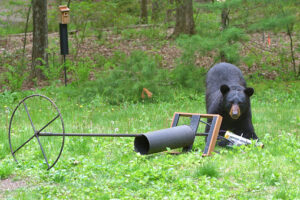
Bear Raiding Feeders
Well, the bear did it again. It tore up some of the spindles on the porch railing, tipped over a couple of the vegetable pots, and yanked a six-foot portion of our picket fence off the posts. All this to remind me that I should not feed the birds this time of year. It’s May.
So what to do but put away all the feeders? Maybe I can try again in the fall when bears retreat to the dens for their winter snooze.
This pretty much gave me great moments of sadness especially since I’ve had to shed other favorite activities.
Bird Antics Bring Joy
But today was a day of great surprises. My beautiful main stays, the birds, were everywhere. As I sat in the kitchen peering out the window, I spotted the adult turkeys poking their heads above the uncut hay. I could feel their parental thoughts “The coast is clear so keep scrambling forward.” The chicks were not seen but definitely there. A goldfinch zipped over them. Then I saw two wood thrashers near the holly tree scavenging for insects. Oh, my look how that crow struts!
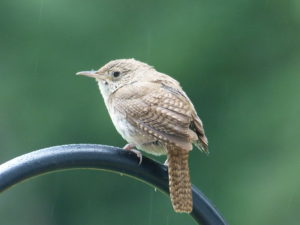
Wrens are Chatterers
Listen, that’s the wren by the back door. She keeps chattering to remind me she built her condo in the hanging planter. Then a flash of bright red caught my eye as I walked onto the porch. It’s a cardinal. Then the female house finch flicked from her nest over the front door light. She doesn’t like me stepping onto the porch. She is quite timid.
Even though the feeders have been down for nearly two months, the birds have kept their vigil at my country home much to my delight. They are in the trees, along the lane, and in the hayfield. What a great day!

























